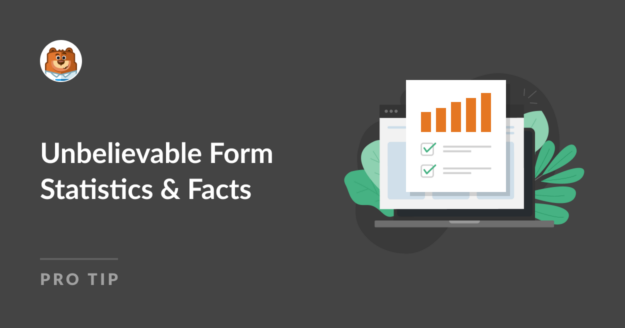AI Summary
Looking to boost your small business with online forms? Our comprehensive collection of online form statistics and facts can help you optimize your forms to drive traffic, generate leads, and convert visitors into customers.
We understand searching the internet for accurate and recent form statistics can be time-consuming. To save you the effort, we’ve compiled over 101 up-to-date online form stats and facts from the latest research to keep you informed of the latest trends.
In This Article
Now, let’s check out these awesome online form statistics and facts!
Online Form Conversion Statistics and Facts
The most common type of lead generation tool among small business owners is a web form. They are easy to add to your website, can capture any information you need from site visitors, and are customizable to match your brand. Plus, they offer site visitors an easy way to subscribe or buy from your company. (Learn more about how online forms work in our guide.)
Here’s a list of helpful online form conversion statistics and facts designed to show you the importance form conversions have on the success of your business, and how design and functionality can affect your overall conversion rates.
1. The average form conversion rate across all industries is 1.7% (Ruler Analytics)
2. Almost 50% of marketers agree that web forms are their highest converting lead generation tool (Hubspot)
3. The average number of form fields is 5. (Hubspot)
4. Local governments tend to publish the longest form with 71 input fields on average (Zuko Analytics)
5. Checkout forms take three minutes and 21 seconds to complete on average (Zuko Analytics)
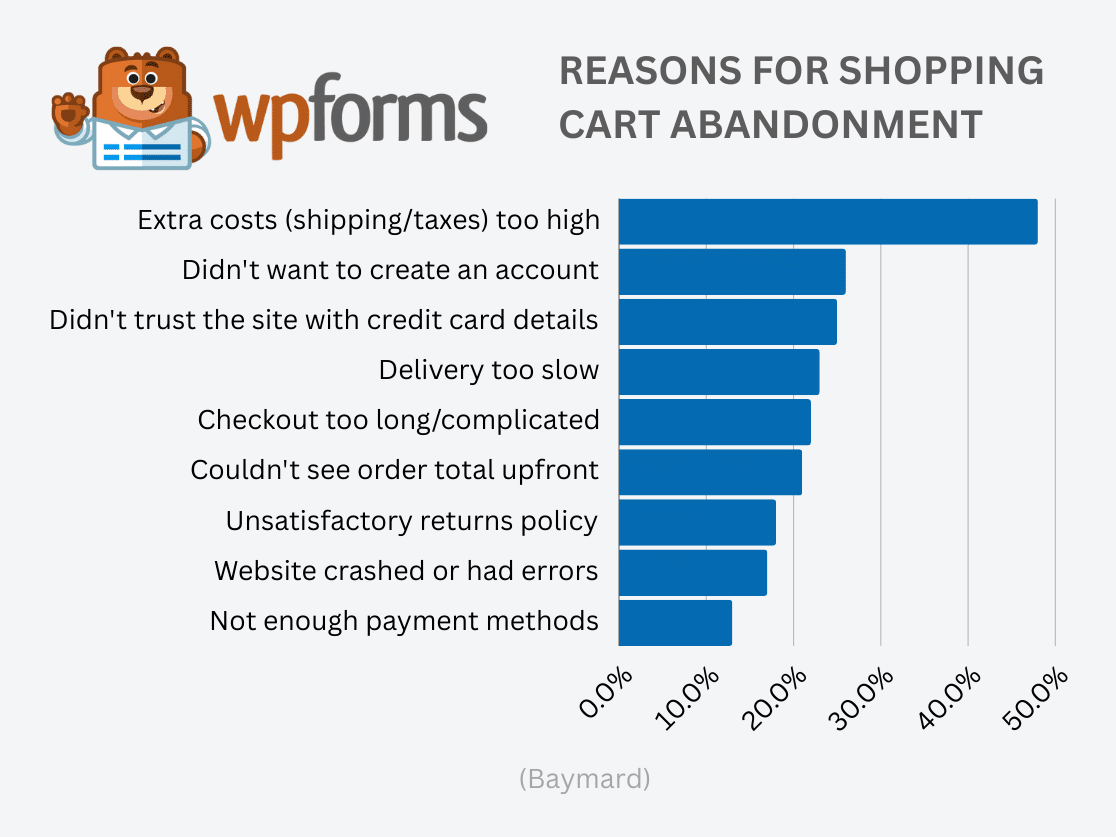
6. The average checkout conversion rate varies widely by industry but is 2.96% on average. (Simpler)
7. Only 40% of marketers use multi-step forms but their conversion rate is 86% higher (Hubspot)
8. Marketers who run A/B tests on their forms report conversion rates that are 10% higher on average than those who don’t use split tests to optimize their forms. (Hubspot)
9. 36% of marketers never run user tests on their forms (Hubspot)
10. Reducing a form from 4 fields to 3 can increase conversion rate by almost 50%. (Quicksprout)
11. Using autofill in forms can increase conversion rate by more than 10% (Zuko Analytics)
12. Over 30% of marketers say they get the highest conversion rates from forms with 4 fields (Hubspot)
13. Popups make up 66% of all signup forms but landing pages have the best signup rates at 23% (Hubspot)
14. Industries with the highest form conversion rates include industrial (2.8%), professional services (2.5%), and B2B services (2.2%). The lowest form conversion rates are found in real estate (0.6%), B2B eCommerce (0.7%), and B2C eCommerce (0.8%). (Ruler Analytics)
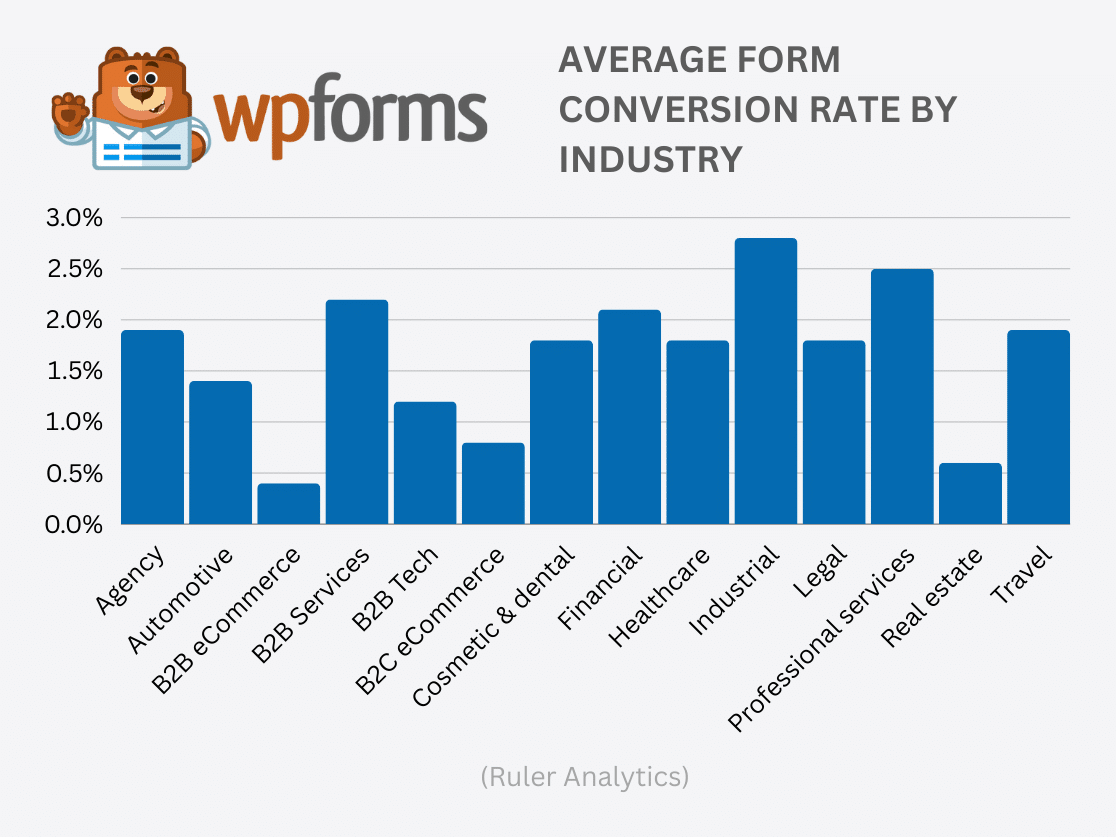
15. Adding social proof to your forms can increase the conversion rate by up to 26%. (GetLeadForms)
16. The average conversion rate of a webinar registration page is 30% from cold traffic. (ConvertKit)
17. CAPTCHAs can reduce form conversion rate by as much as 40%. (Inc.)
18. Dynamic forms can increase conversion rate by as much as 160%. (Chili Piper)
19. The best performing CTA buttons include English action words like “get”, “reserve”, and “try”, rather than “submit” or “enter”. (Wordstream)
20. Simple form design tricks such as placing form labels above the corresponding input fields and matching the size of input fields to the expected length of the answer can increase the conversion rate by reducing friction. (Hubspot)
21. CTA buttons such as form submit buttons surrounded by more white space (easily added by editing the CSS of your form) can increase conversion rates by over 200% (VWO)
22. Average conversion rates for online shoppers in the USA are slightly higher on desktop devices and tablets (3%) compared to mobile devices (2%). (Statista)
23. Forms and other content placed above the fold capture 57% of page-viewing time (Nielsen Norman Group)
24. Static forms perform better than modal forms in a pop-up, with an average success rate of 45.53% compared to 25.96% for modal forms. (Factors.ai)
25. Organic traffic converts (performs a desired action such as filling in a form on a landing page) at an average of 2.4% while paid traffic from sources like Adwords converts at a lower rate, averaging 1.3% (First Page Sage)
Form Abandonment Statistics and Facts
Form abandonment is something all small business owners struggle with at one point or another.
Luckily, arming yourself with the essential statistics and facts like the ones we’ve rounded up can help you discover reasons why your forms may not be performing as well as you want and make improvements that can reduce order form abandonment and increase conversions and online sales starting right now.
And if you’re using WPForms Pro, you already have 2 awesome tools to help you fight abandonment: our Form Abandonment addon, and our Save and Resume addon.
1. Two-thirds of people who start filling out a form successfully complete it – (Zuko Analytics)
2. Over 80% of shoppers abandon booking and checkout forms (SaleCycle)
3. 81% of people have abandoned at least one web form (The Manifest)
4. The password field has the highest abandonment rate on a form but email and phone number fields also cause people to drop out. (Zuko Analytics)
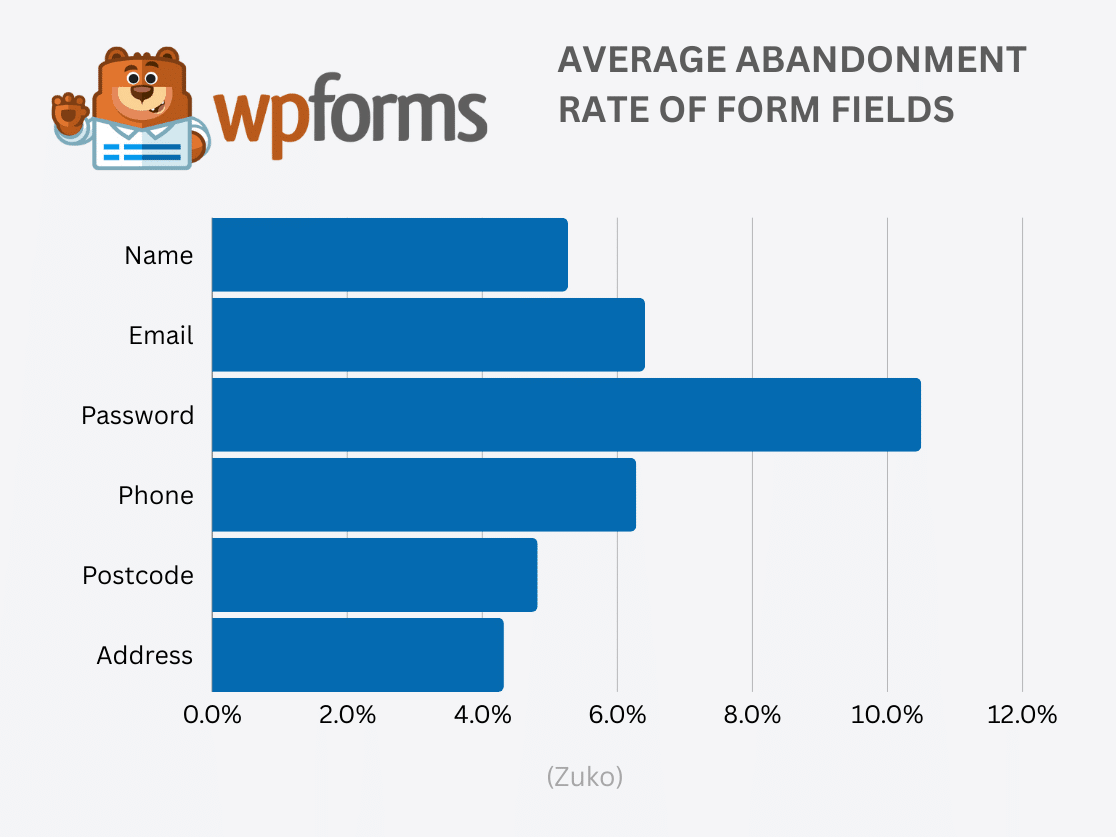
5. 20% of partial form responders will come back and complete the form if they are sent a link to the incomplete form. (Formsort)
6. Application forms boast the highest completion rate of any type of form, with 75% of those who start filling it out completing it. (Zuko Analytics)
7. Inline form-field validation causes an average 22% decrease in form errors and decreases the time taken to complete the form by 42%. (CXL)
8. The average form abandonment time is 1 minute and 43 seconds. (Feathery)
8. Forms with radio buttons can be completed an average of 2.5 seconds faster than a form with dropdown selection fields. (CXL)
9 The average checkout displays twice as many form fields as needed. (Baymard)
10. 88% of checkout forms don’t include a single “Name” field, increasing friction and the time it takes to complete a form. (Baymard)
11. Users complete single-column forms an average of 15.4 seconds faster than multi-column forms (CXL)
12. Security concerns are the most common reason for users abandoning a form, at 29%. Adding trust badges can help to allay these fears, especially when added to checkout forms. Form length is also a common deterrent, with 27% of users abandoning a form because it is too long. Advertisements or upselling is responsible for 11% of abandonments and a further 10% cite an unclear reason for collecting information. (The Manifest)
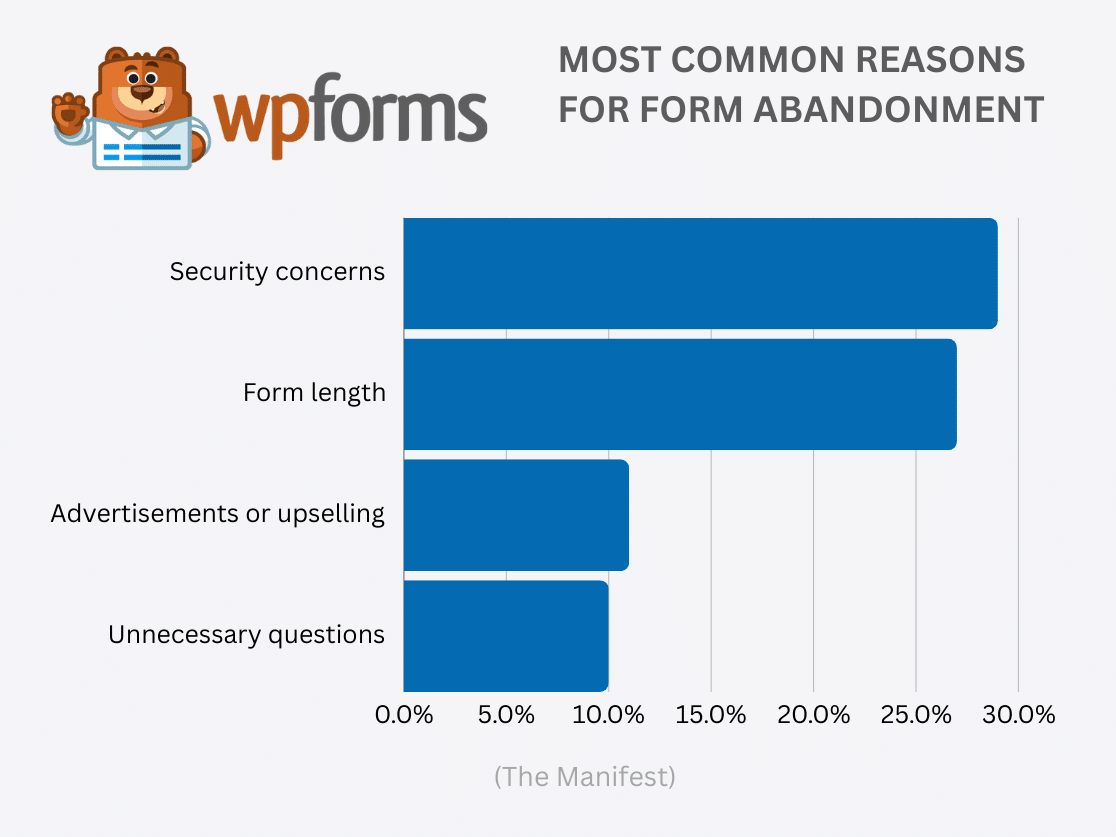
13. 84% of people prefer to fill out forms on a laptop or desktop computer. Only 3% prefer to fill out forms on a mobile device. (The Manifest)
14. A typical survey form response rate ranges from 5-30%. Surveys sent to B2B audiences typically experience a response rate of 10-15% higher than B2C industries. (Survey Planet)
15. More than 67% of site visitors will abandon your form forever if they encounter any complications; only 20% will follow up with the company in some way. (Insightful)
16. 50% of employers claim the length of their job application forms is effective at weeding out applicants who don’t want to finish. (SHRM)
17. The average form abandonment rate is highest for the automotive industry (82%), followed by travel (49%), eCommerce (49%), and property (48%). It’s lowest for local government (3%) and insurance (6%). (Zuko)
18. Unexpected costs or hidden fees can cause 12% of users to abandon a form at checkout. (Baymard)
19. Over 44.1% of abandoned cart emails are opened and almost a third of clicks lead to recovered sales. (Dynamic Yield)
20. Personalized CTA buttons can increase conversions by over 200%. (Hubspot)
21. 60% of shoppers will abandon a checkout form if there is no return policy or the return policy is unclear. (SureCart)
Lead Generation Statistics and Facts
Attracting potential customers through channels like search engines, social media, and advertisements is essential for growing your business.
WordPress lead generation plugins can help to boost your lead generation efforts. We’ve also compiled these key stats and facts specifically focused on the effectiveness of online forms in lead generation.
1. 84% of marketers use form submissions to generate leads. (Ruler Analytics)
2. 61% of marketers said their biggest growth-related challenge is generating leads. (Hubspot)
3. Companies generating 40% or more of their leads through online methods such as online forms grow 4x faster than companies that generate more of their leads through offline channels. (Hinge Marketing)
4. 80% of marketers believe automation drives more leads and 77% of marketers using automation software such as WPForms convert more leads than those that don’t use automation. (APSIS)
5. The form automation software market is expected to reach over $26 billion by 2026. (Forbes)
6. 49.7% of marketers say that web forms are their highest converting lead generation tool. (Hubspot)
7. Only 10-15% of leads convert into sales. (Belkins)
8. Inbound lead generation using methods like online forms costs on average 67% less than traditional outbound marketing and is also more effective. (Hubspot)
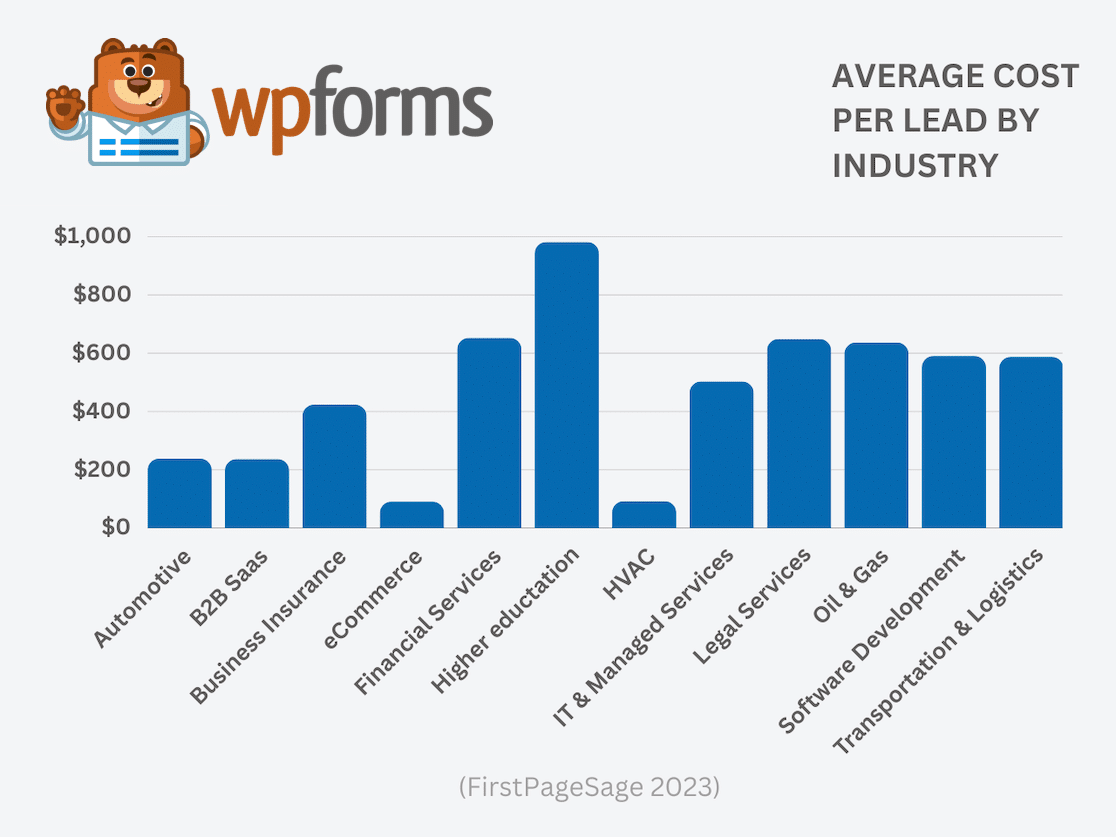
9. Interactive content such as online surveys and calculators can increase conversions by 4x. (Rock Content)
10. 91% of marketers say that lead generation is their most important goal. (Ruler Analytics)
11. 27% of marketers consider lead generation one of their most important metrics for measuring the effectiveness of their content marketing strategy. (Hubspot)
12. 68% of online experiences begin with a search engine. (BrightEdge)
13. Over 40% of marketers say that webinars and online events performed better than their other content assets in the last 12 months. (Content Marketing Institute)
14. Companies that excel at lead nurturing generate 50% more sales-ready leads at a 33% lower cost (Adobe).
15. An 80% majority of marketing professionals surveyed say that having automation software is an important part of improving lead nurturing performance. (Ascend2)
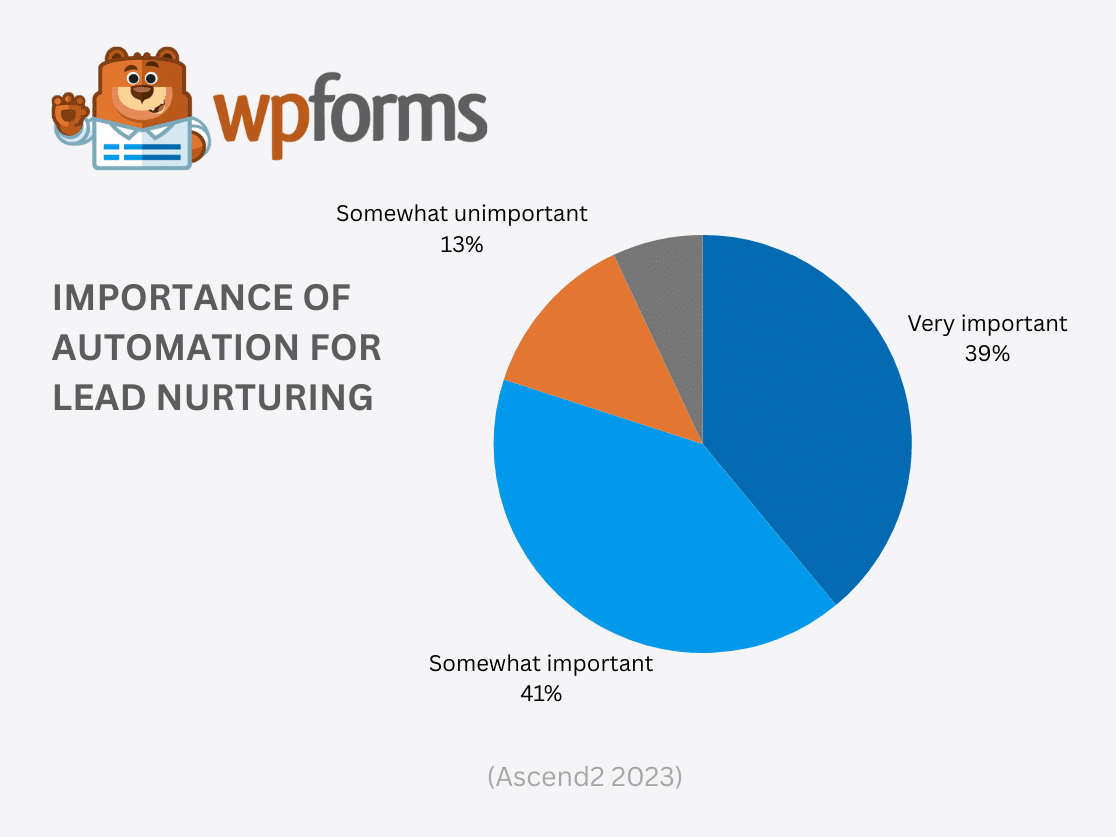
16. Only 10.9% of marketers agree that only the name and email are essential for a landing page form. 26.5% think a phone number is important. (Hubspot)
17. 66% of marketers say that the quality of leads is one of the most important metrics to measure the success of their content marketing campaigns, while 43% agree that the quantity of leads provides meaningful insights. (Content Marketing Institute)
18. 53% of marketers spend at least half of their marketing budget on generating leads. (BrightTALK)
19. In 2023, Web conversions saw a nearly 11% increase, and inbound leads increased by 6.66%. (Hubspot)
20. 79% of brands use content to generate leads. (Adobe)
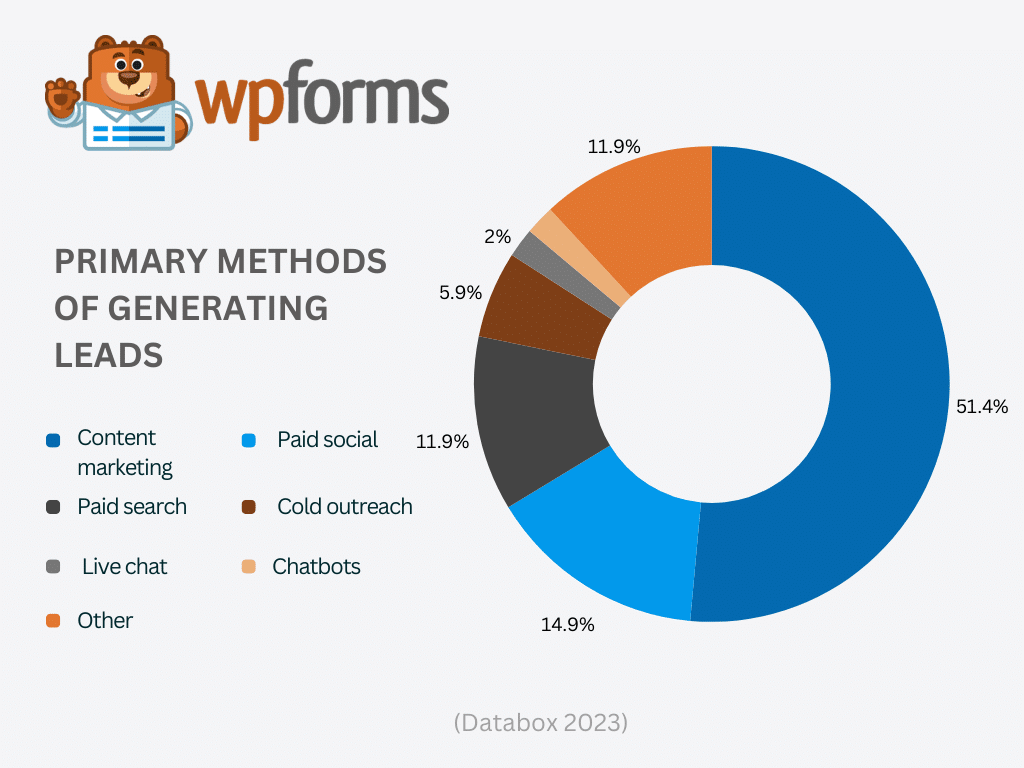
21. 85% of B2B marketers use content to generate leads, compared to just 60% of B2C marketers. (Exploding Topics)
22. 29% of marketers use a search-optimized website and blog to attract and convert leads. (Hubspot)
23. 27% of marketers say that organic search generated the majority of their leads. (Ruler Analytics)
24. SEO leads are 8x more likely to close than those generated by traditional marketing. (Web FX)
25. SEO drives 1,000%+ more traffic than organic social media. (BrightEdge)
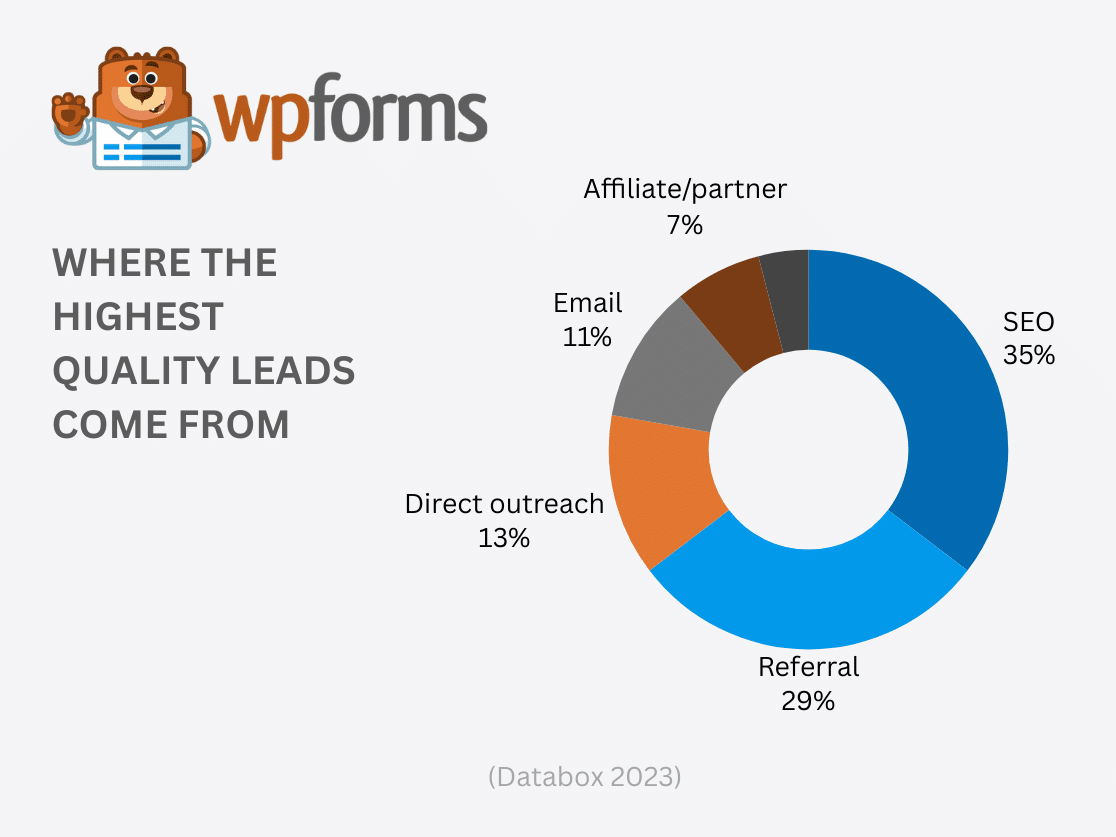
26. More than half (53%) of marketers say gated webinars (with an online signup form) are the top-of-the-funnel format that generates the most high-quality leads. (Demand Gen Report)
27. 44% of B2B organizations gate content. Of those that do, 62% say the main reason is to identify qualified leads. (Walker Sands)
28. B2B Companies generate 2X more revenue from organic search than any other channel. (BrightEdge)
29. Webinars are the most popular type of content for B2B influencer marketing, with 81% of B2B marketers citing them as the most effective type of content (Search Engine Journal)
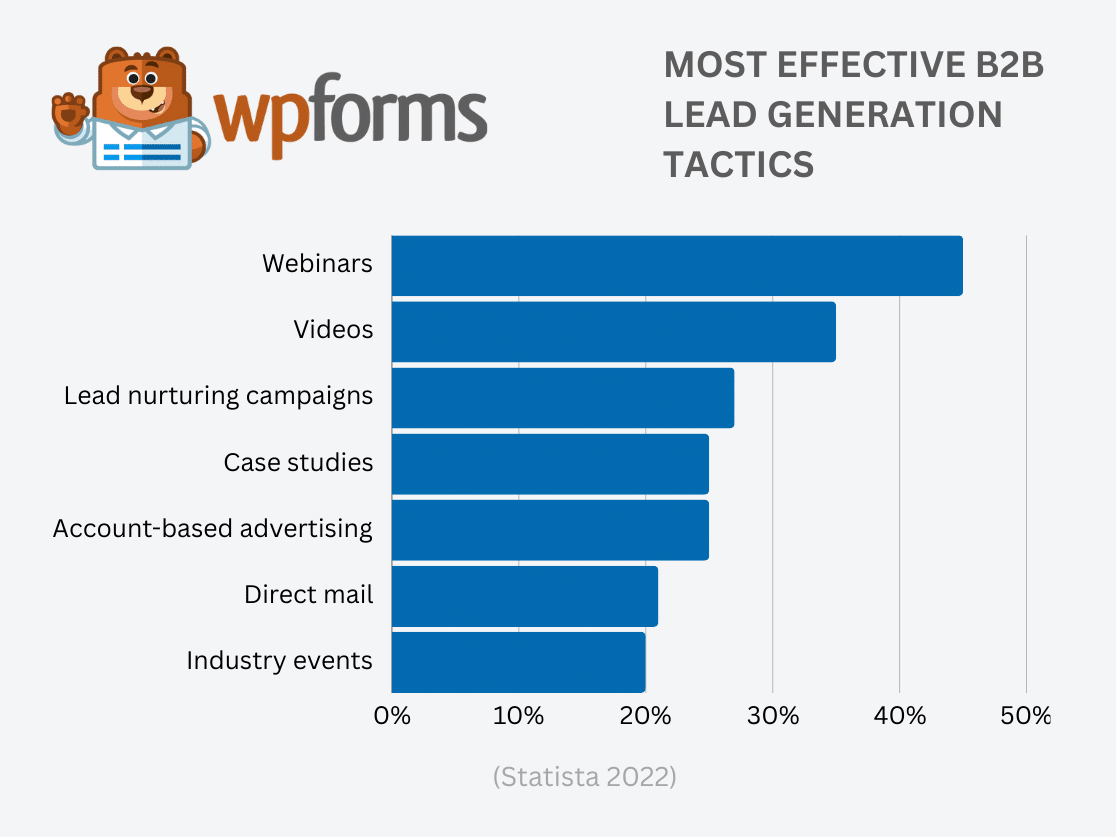
30. 78% of brands say they struggle with “data debt” or not having enough quick data about their customers to not launch relevant personalization tactics. (Experian)
Email Marketing Statistics and Facts
Email is one of the best ways to reach out to interested site visitors and you can even automate the process to make things easier for you and your team.
WPForms makes collecting email addresses for your email marketing simple and easy. Just create a simple contact form (or any other type of form for that matter) and add an email signup checkbox for site visitors to select so you can send campaigns to them, drive traffic to your site, and re-engage people after they’ve left your site.
Now let’s look at some email marketing stats and facts as they relate to your business as a whole and your use of online forms to capture lead data and market to your target audience.
1. There were 4.26 billion users at the end of 2022, predicted to increase to 7.73 billion by 2026. (Statista)
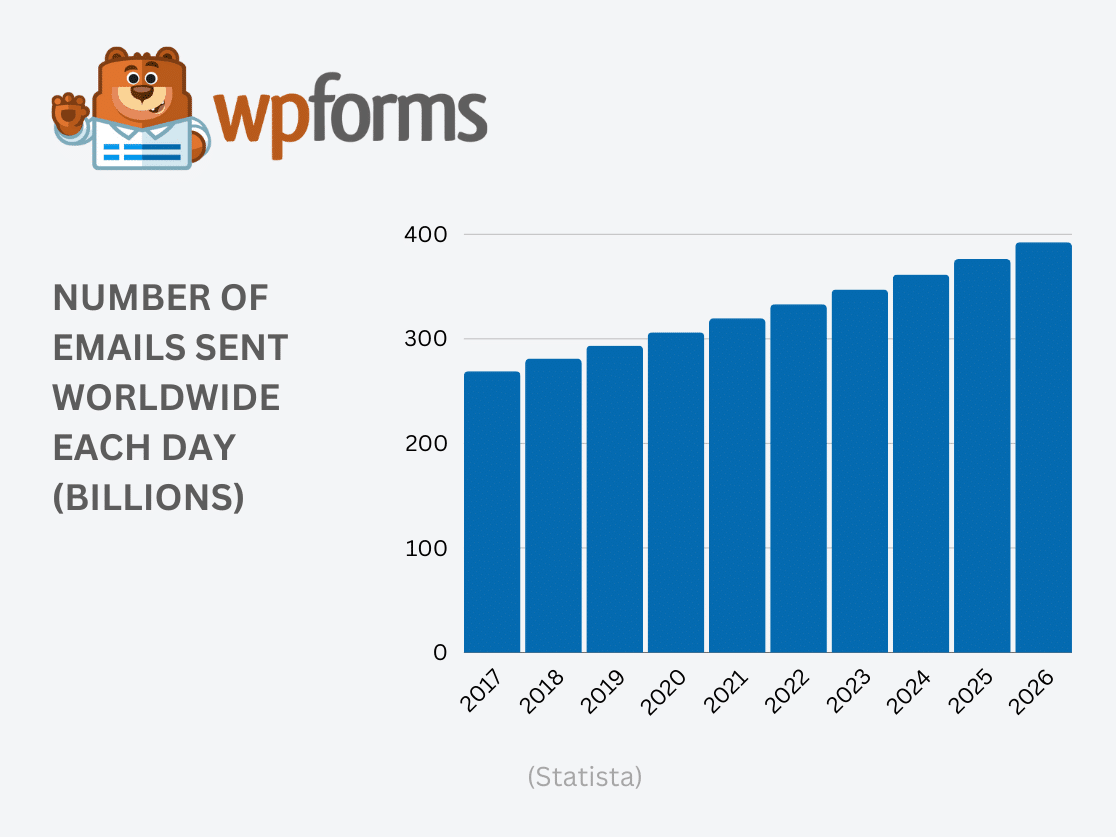
2. Email collection forms convert relatively highly, with an average conversion rate of 15%. (Hubspot)
3. Email marketing has an average ROI of $36 for every $1 spent. (Constant Contact)
4. 90% of Americans subscribe to at least one email newsletter from a business, with 74% subscribing to between 2 and 10. (Storydoc)
5. 97% of Americans check their email inbox at least once a day. (Storydoc)
6. 31% of marketers use email marketing. (Hubspot)
7. Global email marketing revenue is expected to reach 17.9 billion dollars by 2027. (Statista)
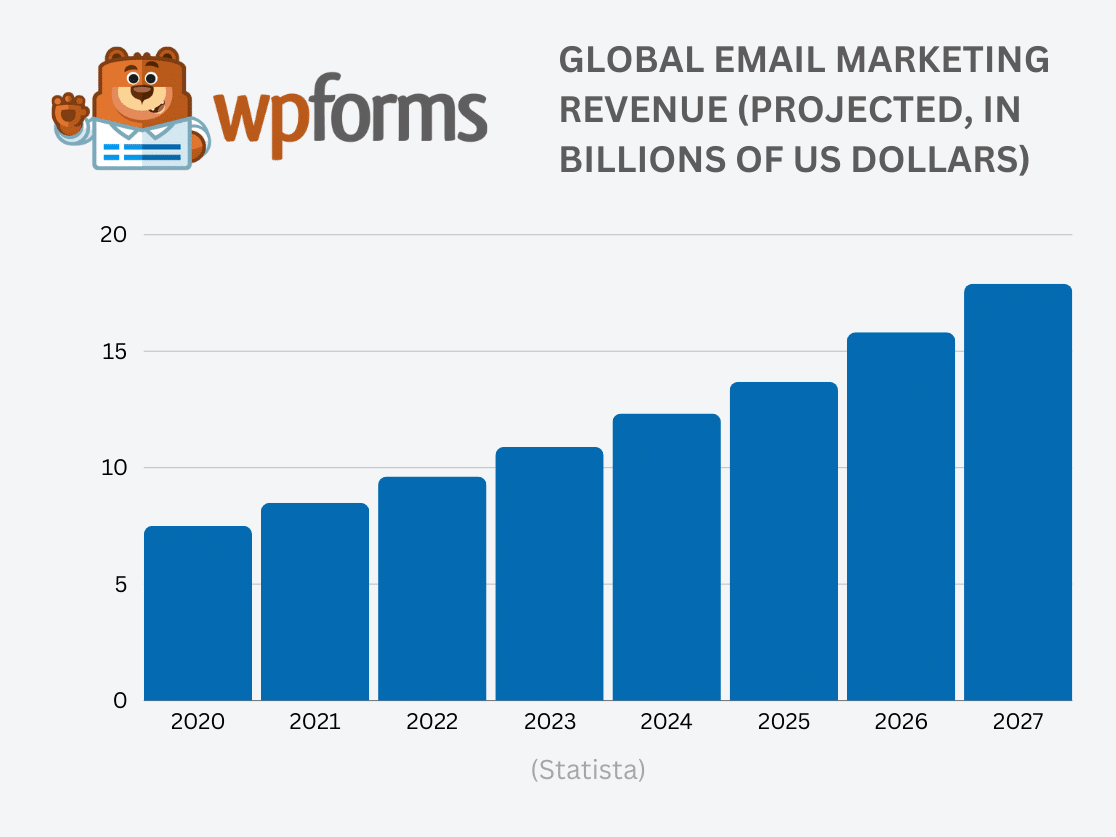
8. 29.7% of businesses plan to increase their email marketing budget in the next year. (Litmus)
9. 55% of consumers say email is their preferred channel for communication with businesses. (Constant Contact)
10. 64% of Millennials agree that automated emails are a good way for brands to communicate with their customers. (Storydoc)
11. 39% of people subscribe to a newsletter to receive discounts, 16% want exclusive content, and 5% sign up to receive product updates and announcements. (Storydoc)
12. 34% of consumers are more likely to purchase from emails than any other marketing channel. (Litmus)
13. The main reason for unsubscribing from a list is too many emails, with 52% of people citing this as their main reason. 24% say irrelevant emails were the reason for unsubscribing, 11% don’t like non-personalized emails, and 9% complain about emails that are too salesy. (Storydoc)
14. 53% of people like receiving onboarding emails after signing up for a product or service and 41% of people want to keep receiving emails after onboarding. (Storydoc)
15. Newsletters are the most common type of emails sent by businesses, with 81% of marketers sending this type of email. Other common marketing emails include welcome emails (sent after signing up to the list via an online form), product emails, and sales and promotions. (Litmus)
16. 83% of customers are willing to share their data to create a more personalized experience. (Accenture)
17. The most effective strategies for email marketing are subscriber segmentation (78%) and message personalization (72%). (Hubspot)
18. 21% of emails are opened within the first hours of sending. (Constant Contact)
19. The average email open rate across all industries is 21.33% (Mailchimp)
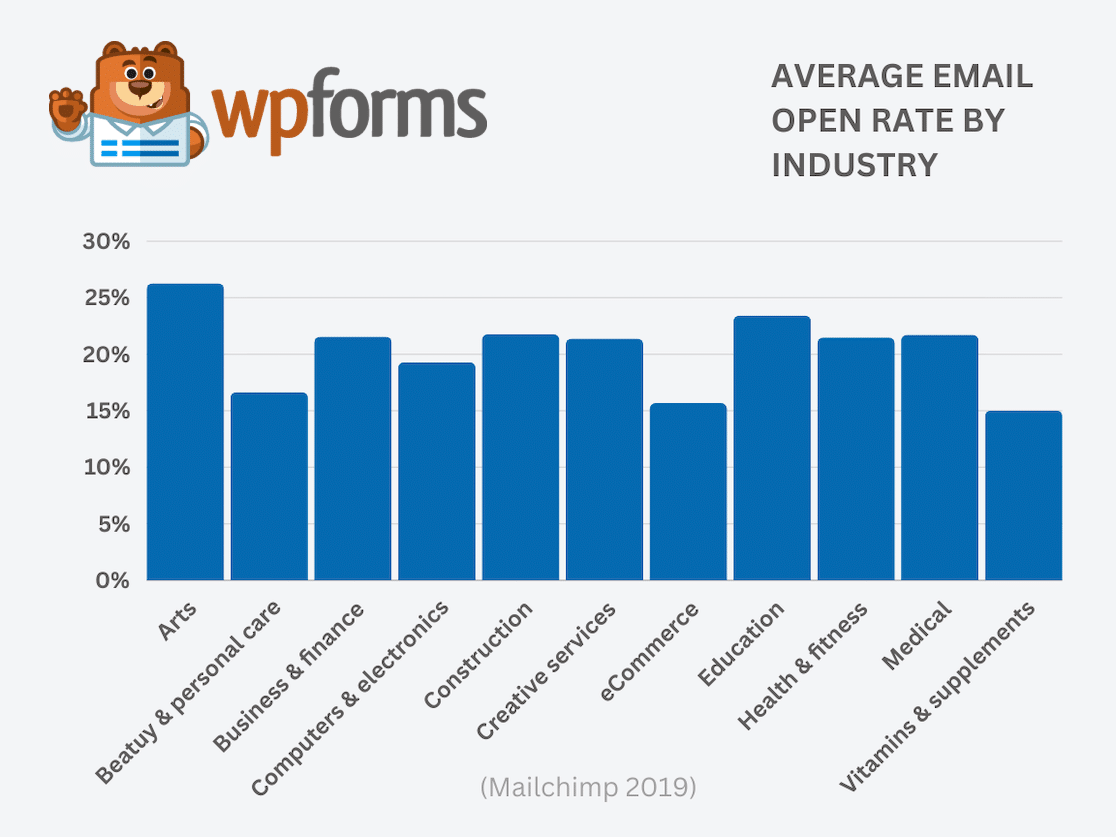
20. 46.9% of email sales come from automated emails. (Omnisend)
21. Automated email messages (those triggered by user actions such as submitting a form) have a 91.5% higher open rate than scheduled email campaigns. (Omnisend)
22. 69% of marketers say that email is their most frequently used channel during the lead nurturing process. (Ascend2)
23. Segmented email campaigns can increase revenue by as much as 760%. (Campaign Monitor)
24. Around 50% of marketers use lead magnets to capture email addresses. (Hubspot)
25. 91% of consumers want to hear from companies they do business with via email. (Disruptive Advertising)
26. Only 38% of people who fill out web forms receive verification emails. 11% receive no contact at all from a company after filling out a form. (The Manifest)
We’ve got some email marketing statistics for you to check out if you want to see more.
Alright, I’m Ready to Improve My Forms! What’s Next?
Now that you can see just how important online forms are, it’s time to put that knowledge into action.
WPForms Pro is the best way to do that because:
- It’s the easiest form builder available for WordPress, and you can create all of your forms without using any code
- WPForms comes with 2,000+ WordPress form templates for all industries and needs
- The Calculations addon makes it a breeze to create complex order forms and custom quote forms
- Your forms will be safe and secure, which is critical when collecting payment or customer data
- Our Form Abandonment addon lets you capture leads even when forms are not submitted
- The Save and Resume addon lets visitors save partial form entries easily to reduce your abandonment further
- WPForms is fully mobile responsive, so your visitors will be able to use your forms on their phone or tablet
- When you compare SurveyMonkey vs Google Forms vs WPForms, WPForms is the only form builder that directly integrates with WordPress.
Create Your WordPress Form Now
Next, Learn More About Contact Forms
And there you have it! Over 101 online form statistics and facts to help your small business rise above any challenge and succeed this year, whether your focus is on lead generation, email marketing, boosting form conversions, or preventing form abandonment.
If you’re a small business without an online form solution, be sure to check out these reasons why you need a contact form on your site and how WPForms is customizable enough to meet your every form need. It’s the perfect alternative to Typeform if you need awesome features and great support.
Ready to build your form? Get started today with the easiest WordPress form builder plugin. WPForms Pro includes lots of free templates and offers a 14-day money-back guarantee.
If this article helped you out, please follow us on Facebook and Twitter for more free WordPress tutorials and guides.

